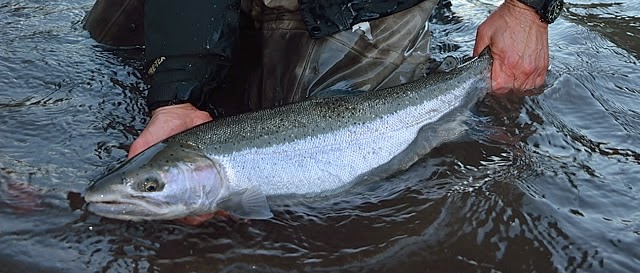Steelhead/Rainbow Trout: Research Review Shows There Is No Normal For Oncorhynchus Mykiss
"Oncorhynchus mykiss" is both a seagoing steelhead and a resident rainbow trout: O. mykiss can be either anadromous, spending much of its life in the ocean, or it can be a resident fish in rivers and lakes.
Scientists have studied O. mykiss for years (at least since 1944) and they still are somewhat puzzled as to how individual fish end up in one camp or the other. That was the subject of a recent survey of the scientific literature of O. mykiss and its life histories.
From the survey, a team of scientists revealed a fish with complex life histories: some remain in the river of their birth and spawn up to five times, some head to the ocean to grow (generally larger than their freshwater brethren) and return to spawn just one time, others dip in and out of the ocean and estuaries during their life history before returning to spawn.
What they do hypothesize is that whatever route the O. mykiss takes, it is the result of a complex interaction of its genes, the condition of the individual fish and the environment.
"There is no "normal" population of O. mykiss," said co-author John McMillan, science director at Trout Unlimited. "They literally are the fish of a thousand faces. They do whatever it takes to survive in a given environment, from large to small and young to old." McMillan at the time of the survey was a contract scientist with Frank Orth and Associates at NOAA Fisheries Northwest Fisheries Science Center.
These are challenging fish to understand, said Neala W. Kendall, research scientist with the Washington Department of Fish and Wildlife, and co-author with McMillan of the survey "Anadromy and residency in steelhead and rainbow trout Oncorhynchus mykiss: a review of the processes and patterns" that was published online this month in the Canadian Journal of Fisheries and Aquatic Scienceshttp://www.nrcresearchpress.com/doi/abs/10.1139/cjfas-2014-0192#.VKNEGSvF9qU.
"Our review indicates that whether a fish migrates to the ocean or matures in freshwater is influenced by interactions among its genes, individual condition (e.g., size, growth rate, fat content), and the environmental conditions it experiences," Kendall said. "While anadromy and residency are affected to a large degree by genetics, individuals might migrate or not based on the conditions in their environment."
Also contributing to the review were Matthew R. Sloat, post-doctoral scholar at Oregon State University; Thomas W. Buehrens, research scientist, Washington Department of Fish and Wildlife; Thomas P. Quinn, professor, University of Washington School of Aquatic and Fishery Sciences; George R. Pess, supervisory research fishery biologist, NOAA Fisheries; Kirill V. Kuzishchin, professor, Moscow State University; Michelle M. McClure, division director, NOAA Fisheries; and Richard W. Zabel, division director, NOAA Fisheries.
As they surveyed the literature (some were from Russian scientists and largely new to the science of O. mykiss in America), they were surprised by some of the inconsistencies in the data about O. mykiss' anadromy and residency, according to Kendall.
One interesting finding was that there is limited support in the literature for a number of commonly-held ideas about why O. mykiss individuals smolt or mature in freshwater, Kendall said. "For example, larger individuals don't always smolt. In fact, body size and growth are not consistent indicators of a fish's life history."
The evidence that the distance that fish must migrate through freshwater to reach the ocean predicted the rates of anadromy was inconsistent. "We were also surprised by the lack of data on both anadromous and resident individuals from a single population," she said.
Still, it was clear in the literature that there is a genetic influence: the tendency to be anadromous or remain in fresh water is at least partly heritable. They found that the "gene expression" that leads to smolt transformation is different, and there appear to be genetic differences in metabolism, "with anadromous individuals having higher metabolism costs than residents" (Sloat and Reeves, 2014), the report says.
The genetics does not preclude a resident rainbow trout from migrating to the ocean, nor a steelhead to stay put in freshwater.
The condition of individual fish is also telling, with higher levels of lipids (contributing to whole body fat) in resident fish. Looking at O. mykiss individuals in Southwest Alaskan streams and in the Deschutes River, both areas where the vast majority of O. mykiss remain in the river, it is clear that a rich food supply in the rivers precludes the need to seek food in the ocean.
The stream environment is a factor. Residency is higher in watersheds with cooler water temperatures, "higher summer flows, an abundance of food and adequate spawning habitat for smaller females," the report says. "Such conditions appear to maximize opportunities for development and survival in freshwater, thereby reducing the advantage of an ocean migration."
"Our review suggested that residents tended to be most abundant in streams with more stable flow regimes, relatively cold water temperatures and productive food supplies," McMillan said. "Testing this requires further research, but the hypothesis seems plausible if we consider that migration to the ocean is only necessary if a large enough size cannot be reached in freshwater. In other words, there is little reason for a fish to migrate to the ocean if its growth and reproductive needs can be met in freshwater."
Finally, males and females are different and they tend to do different things, according to McMillan. "Males more frequently become residents and females more frequently become anadromous." He said the reason is "related both to size and behavioral tactics."
The authors suggest four categories for future study as they hone in on the anadromy/residency question for O. mykiss. They suggest studies that will help to clearly understand the effects of water temperature, the impact of food supplies and studies that will more explicitly test the effects of freshwater migration cost and marine survival on anadromy. "Lastly, it would be interesting to evaluate whether declines in anadromy over long and short time periods are associated with an increase in residency . and what those implications are for future environmental change," the report says.
"I hope the paper highlights that O. mykiss as a species is really about their suite of life histories, the frequencies of which appear to be highly variable," McMillan said. "And each life history can give rise to one another, and these patterns may change over time. It is very difficult to manage for this type of complexity. Nonetheless, it appears that such life history diversity is fundamental to the evolutionary success of O. mykiss."
From The Columbia Basin Bulletin at www.cbbulletin.com.






















